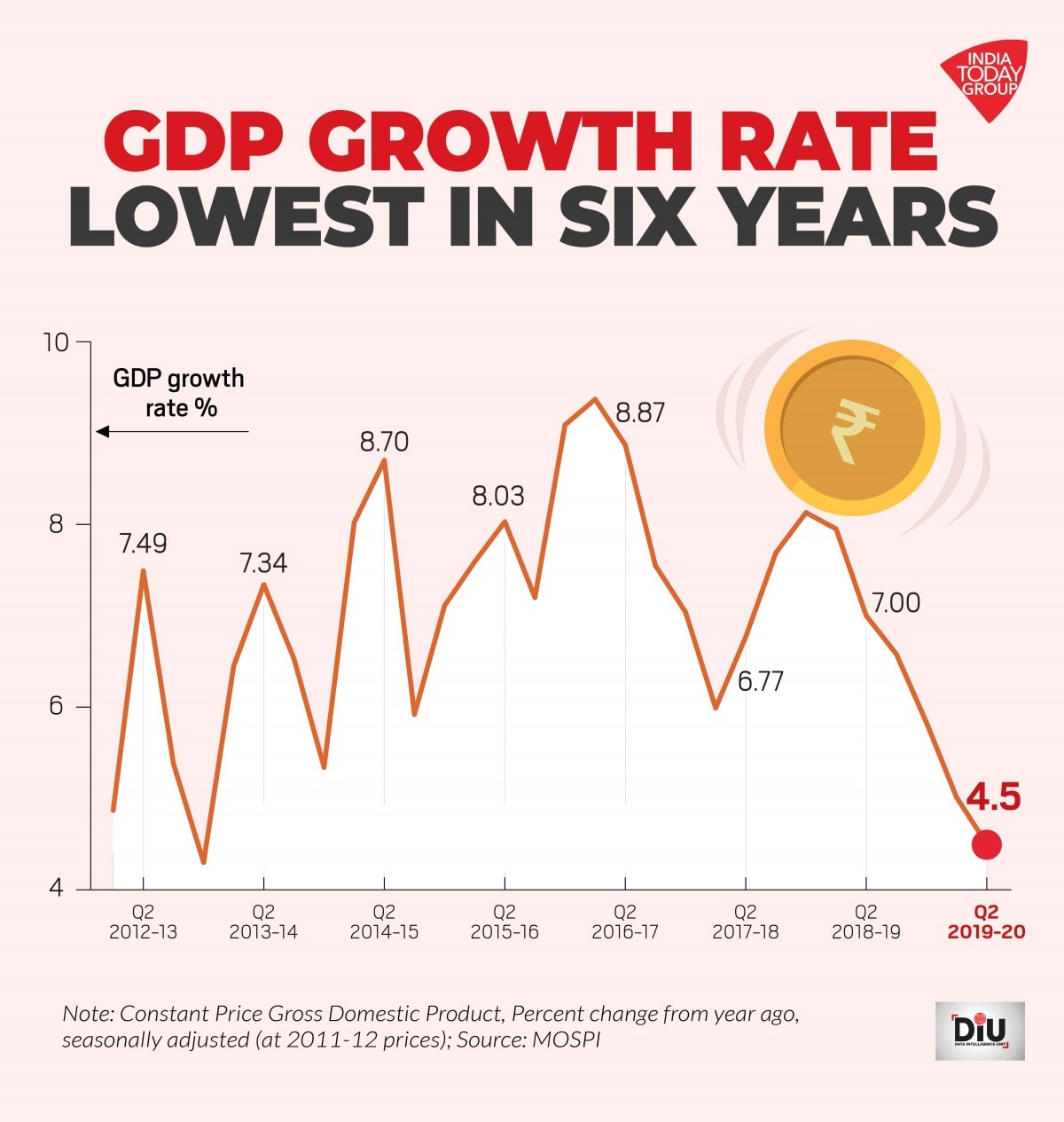


The Indian economy saw a slump in its GDP growth rate in the second quarter of the current fiscal year, coming in at only 5.4% compared to the projected 6.5%. This decrease was driven by slow growth in manufacturing and mining, along with weak government expenditure and private consumption. However, the Ministry of Statistics and Programme Implementation remains hopeful, stating that the overall growth in the first half of the fiscal year was 6.2%. The Reserve Bank of India has projected a growth rate of 7.2% for the full fiscal year.
India's GDP Growth Slumps to 5.4% in Q2
India's economic growth slowed to a five-quarter low of 5.4% in the second quarter (Q2) of the current fiscal year (FY23), falling short of expectations. This marks a significant decline from the 6.5% growth recorded in the previous quarter (Q1).
Key Factors Driving the Slowdown
The slowdown in economic activity was primarily driven by weaker performance in manufacturing, mining, and quarrying sectors. Manufacturing growth decelerated to 4.3% from 14.3% in Q1, while mining and quarrying contracted by 2.4%. Additionally, government expenditure and private consumption remained subdued, further dampening growth.
Impact on the Broader Economy
The GDP slowdown raises concerns about the health of the Indian economy. Slower growth could lead to job losses, reduced consumer spending, and weaker investment activity. The government's fiscal deficit may also widen as revenue collection slows.
Government Response and Outlook
Despite the disappointing Q2 performance, the Ministry of Statistics and Programme Implementation has expressed optimism for the overall fiscal year. The first half of FY23 witnessed growth of 6.2%. The Reserve Bank of India (RBI) has projected a full-year growth rate of 7.2%.
Top 5 FAQs and Answers
1. What caused the slowdown in Q2 GDP growth?
Slow growth in manufacturing, mining, and quarrying, along with weak government expenditure and private consumption.
2. What is the impact of the GDP slowdown?
Reduced consumer spending, potential job losses, and a wider fiscal deficit.
3. What is the government's response?
The government remains optimistic and expects to achieve 6.2% growth in the first half of FY23 and 7.2% for the full year.
4. What are the prospects for future growth?
The RBI has projected a growth rate of 7.2% for FY23, but uncertainty remains due to global economic headwinds.
5. How does the current slowdown compare to past economic downturns?
The current slowdown is less severe than previous economic crises such as the 2008 global financial crisis. However, it highlights the vulnerability of the Indian economy to external shocks and the need for sustainable growth strategies.

Union Home Minister and Minister of Cooperation, Amit Shah, congratulated Amul and Indian Farmers Fertiliser Cooperative Limited (IFFCO) for securing the first and second ranks in the global ranking for cooperatives. This achievement is a testament to the boundless potential of cooperatives, which are being transformed into a global model of empowerment and self-reliance by Prime Minister Narendra Modi. The dairy sector, which is the backbone of rural livelihoods in India, has combined farmer-led cooperatives, women's participation and scientific practices to achieve remarkable progress. Additionally, the National Co-operative Exports Limited, set up by the government, has achieved a significant milestone in exporting agricultural commodities.

After purchasing his retirement property in Swansea, David Barlow has been forced to live in a motorhome on his driveway due to persistent damp and mould issues. Despite complaints to his property managers, the issue has not been resolved and Barlow fears for his belongings. The problem is believed to have been caused by faulty insulation installed by British Gas, but the company denies responsibility. This situation has put a hold on Barlow's retirement plans and has left him feeling frustrated and stuck.

US-based private equity firm Tillman Global Holdings (TGH) is reportedly in advanced discussions to invest up to $6 billion in Vodafone Idea Ltd, which could lead to a change in operational control. However, the investment is contingent on the Indian government providing comprehensive relief covering AGR and spectrum payment dues. If the deal goes through, it could dilute existing promoter holdings, including those held by Aditya Birla Group and Vodafone Plc. While the news has boosted investor sentiment, analysts caution that government approval and debt restructuring clarity are key to the execution of the deal.

The Indian real estate market is undergoing a major shift with rising home prices, as apartments priced between Rs 2 crore and Rs 5 crore now dominate sales. This change has been highlighted by a Redditor who expressed concerns over the dwindling chances of middle-class buyers to afford a house. According to a Moneycontrol report, the trend is a result of big developers focusing more on luxury projects, leaving affordable housing in the backseat. As a result, home ownership for the middle-class seems like a distant dream, with even government employees struggling to afford these expensive properties.

Vodafone Idea's share price saw a significant increase of 14% after the Supreme Court provided further clarity on the AGR dues issue. The court clarified that the government can consider providing relief for both additional and reassessed AGR dues, giving some respite to the struggling telecom operator. At the time of writing, Vodafone Idea's share price was trading at Rs 9.51, with a gain of 8.93%. This comes after the court's previous hearing which did not provide a clear ruling on whether the relief applies to only Vodafone Idea's plea or the entire pending AGR amount of nearly Rs 80,000 crore.

After failing to meet Apple's internal sales expectations, the ultra-thin iPhone Air is facing a significant production cut of 80%. The initial prediction of reducing production by one million units has now been deemed insufficient, highlighting deeper concerns about the device's market performance. This setback raises questions about the competitive landscape of high-end smartphones and hints at Apple's next possible move towards a foldable iPhone.

In an effort to secure their rights to their intellectual property, the Board of Control for Cricket in India (BCCI) has announced a new copyright agreement that will be in effect until 2025. This move ensures that BCCI maintains its exclusive right to reproduce, broadcast, and use any of its content, including images and videos, for commercial purposes. With the deal also covering the use of BCCI's logos and trademarks, it gives the governing body a tighter grip over its assets and sets a precedent for other sports organizations to follow suit.

The Social Security Administration recently released updates for 2026, including a potential 2.7% increase to benefits. However, the official announcement of the cost-of-living adjustment (COLA) could be delayed due to the government shutdown. While an increased COLA is positive for beneficiaries, some argue that it still may not keep up with the rising cost of living. Additionally, beneficiaries who currently receive physical paper checks will need to make arrangements for direct deposit or a Direct Express card to continue receiving their benefits.

The Indian government has given its approval for the formation of the 8th Central Pay Commission, which will be tasked with assessing and making recommendations around pay, benefits, and working conditions for over 1.2 crore central government employees and pensioners. The Commission, which will have a chairperson, a part-time member, and a member-secretary, will have 18 months to complete its work and will also look at emolument structures and conditions in the private sector and CPSUs. The recommendations are expected to be implemented from January 1, 2026.

Prime Minister Narendra Modi launched the Gyan Bharatam Portal, dedicated to preserving and promoting India’s vast and unique manuscript heritage. Speaking at the Gyan Bharatam International Conference, PM Modi emphasized the importance of preserving India’s knowledge legacy and adapting to changing times. He also highlighted how the ancient manuscripts reflect India’s diverse cultural heritage and contribute to humanity’s progress in various fields.